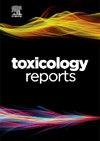Determination of nitrofuran metabolites in sausage casings and crawfish using LC-Q-Orbitrap HRMS: Method development and validation
Q1 Environmental Science
引用次数: 0
Abstract
This study developed and validated an analytical method for determining four nitrofuran (NF) metabolites in sausage casings and crawfish matrices. The method utilizes liquid chromatography coupled with quadrupole-Orbitrap high-resolution mass spectrometry (LC-Q-Orbitrap HRMS) to analyze these metabolites. The validation of the developed method was carried out in accordance with the Commission Implementing Regulation (CIR) EU 2021/808, using three concentration levels ranging from 0.25 to 0.75 μg/kg. The recoveries ranged from 77 % to 109 %, while both repeatability and reproducibility remained consistently below 15 %. The calibration curves exhibited good linearity, with correlation coefficients (R) exceeding 0.9978. The limits of detection (LOD) ranged from 0.0218 to 0.0596 μg/kg, while the limits of quantification (LOQ) ranged from 0.0719 to 0.1966 μg/kg. The decision limit (CCα) and detection capability (CCβ) values ranged from 0.30 to 0.39 μg/kg and 0.29–0.35 μg/kg, respectively. Out of 30 crawfish samples collected from local markets in Egypt, 16.66 % contained NF metabolites residues, whereas sausage casings showed no NF metabolite residues. The reliability of the method was further demonstrated through successful participation in two proficiency testing (PT) rounds.
LC-Q-Orbitrap液相色谱法测定香肠肠衣和小龙虾中硝基呋喃代谢物:方法建立与验证
本研究建立并验证了测定香肠肠衣和小龙虾基质中4种硝基呋喃代谢物的分析方法。该方法采用液相色谱-四极-轨道rap高分辨率质谱法(LC-Q-Orbitrap HRMS)对这些代谢物进行分析。根据欧盟委员会实施法规(CIR) EU 2021/808,使用0.25至0.75 μg/kg的三个浓度水平对所开发的方法进行验证。加样回收率为77 % ~ 109 %,重复性和再现性均低于15 %。校准曲线线性良好,相关系数(R)大于0.9978。检出限为0.0218 ~ 0.0596 μg/kg,定量限为0.0719 ~ 0.1966 μg/kg。决策限(CCα)和检测能力(CCβ)值分别为0.30 ~ 0.39 μg/kg和0.29 ~ 0.35 μg/kg。在埃及当地市场收集的30个小龙虾样本中,16.66 %含有NF代谢物残留,而香肠肠衣则没有NF代谢物残留。通过成功参与两轮能力测试(PT),进一步证明了该方法的可靠性。
本文章由计算机程序翻译,如有差异,请以英文原文为准。
求助全文
约1分钟内获得全文
求助全文
来源期刊

Toxicology Reports
Environmental Science-Health, Toxicology and Mutagenesis
CiteScore
7.60
自引率
0.00%
发文量
228
审稿时长
11 weeks
 求助内容:
求助内容: 应助结果提醒方式:
应助结果提醒方式:


